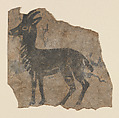Ibex or Gazelle, Block Print
This image depicts an ibex or gazelle facing left on a page of brownish, thick, crumbly paper of a type associated with Fatimid, Ayyubid and Mamluk Egypt. The animal has a large eye ringed in white and diagonal stripes of white representing its hairy chest. The treatment of the eye suggests that this is a Nubian ibex, since that species has brown eyes, whereas the sand gazelle’s eyes are black. Its horns rise up from its head, curving slightly, but are not as large and rounded as those of an adult Nubian ibex, which indicates that the animal is a juvenile. Other markings indicated with white appear on the animal’s belly, legs, head and rump. The ink has bled into the paper at the right, extending from the animal’s leg, and at the left near its chest. Other areas of discoloration are visible behind its head and tail. Traces of white pigment around the body of the ibex suggest that originally the silhouette effect was stronger than it is now. Unlike the many other fragments from Fustat, this one is printed, an extremely rare technique in Islamic art and almost exclusively reserved for amulets. While other images of animals are known from the Fatimid period and possibly later, they are painted or drawn and can usually be associated with a text.
Due to rights restrictions, this image cannot be enlarged, viewed at full screen, or downloaded.

